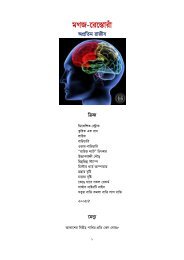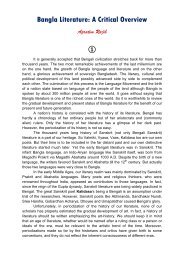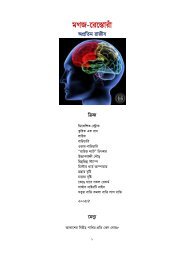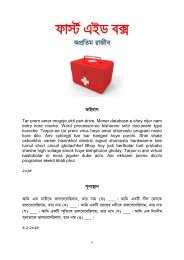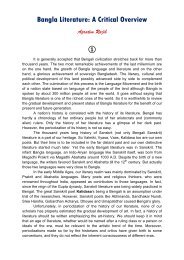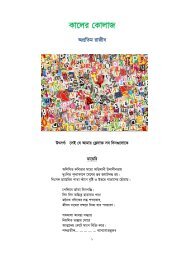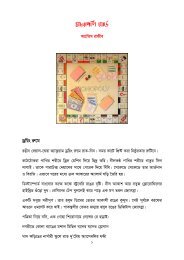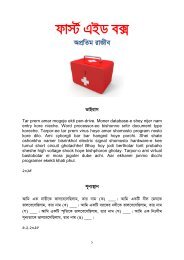Literature-Critique
Create successful ePaper yourself
Turn your PDF publications into a flip-book with our unique Google optimized e-Paper software.
37<br />
Saratchandra Chattopadhyay (1876-1938)<br />
Saratchandra was a desperate and lonely passer-by in the way of progression<br />
of the Bengali Hindu community. Despite being a son of a conservative Brahmin<br />
family, he torn out of his social net and became a bright star in the whole history of<br />
the Bengalis’ effort of gaining social and psychological liberty. In spite of writing in<br />
the great Tagore’s era, he presented unique creations and bluntly saying, surpassed<br />
even Tagore in artistry of the genre of novel. And so much progressive outlook is<br />
hardly found in other contemporary Bengali writers’ works.<br />
In most of his works Sarat depicts social evil, some good men’s fight against it<br />
and human (especially female) psyche; and he was a propagandist against the<br />
institution of marriage.<br />
His early attempt Devdas, although poor in structure, gives a little hint to his<br />
progressive and revolutionary mind. It is the story of a young man who dies out of<br />
anguish for his fatal love-affair. His Palli-Samaj (Country-Society) is a good portrayal<br />
of an unconsummated love-affair in Bengal’s rural society.<br />
Arakshaniya (The Eligible Girl) is the story of a girl of dark complexion, whose<br />
mother finds it too difficult to marry her off. It results in her pitiable humiliation in the<br />
society. This novel questions the anachronistic values of the heartless society that<br />
considers physical beauty (and fair complexion) a must for the female.<br />
Chandranath is the story of another girl’s disgrace – this time, for being a<br />
‘dishonest’ mother’s daughter.<br />
Charitrahin (The Characterless) questions the character of a society itself that<br />
suppresses its members’ carnal desires due to traditional and outdated concepts. It<br />
tells us two stories alongside; one of them is of a love-affair between a babu and her<br />
maidservant; the other tale is of a similar relationship of a widow and her distant<br />
brother-in-law. The first one ends in the beloved’s disapproval of a possible marriage<br />
(as she honors the class divide) and the other relationship ends in tragic<br />
consequences as the widow loses her mind.<br />
Grihadaha (Burning of the House) suspects the very existence of a society<br />
that finds itself helpless while perverted and contaminated by the betrayal of its<br />
dishonest members. Here Sarat shows how marital bond loosens for economic<br />
inequality amid a man, his wife’s parental home and her extramarital lover. In it he<br />
masterly depicts illicit love and its consummation through adultery by a lustful man<br />
(Suresh) and his friend’s (Mahim) disloyal wife (Achala). At the same time the writer<br />
portrays the conflict between emotional love and physical impulse. However, with<br />
due apology to his memory, I convict him of corruption in this context; the reason is:<br />
he does not give the reader any scene of intimate relationship between Achala and<br />
her husband Mahim, which he does in case of her and her lover Suresh. Does Sarat<br />
make this bias for commercial accomplishment?<br />
Marital bond loosens due to economic difficulties in Birajbou too. This novel is<br />
also a mirror of physical persecution on those days’ Bengali women. A village<br />
housewife, who is devoted to her husband, endures long days’ poverty and<br />
persecution with great patience, a virtue that those days’ Bengali Hindu women were




